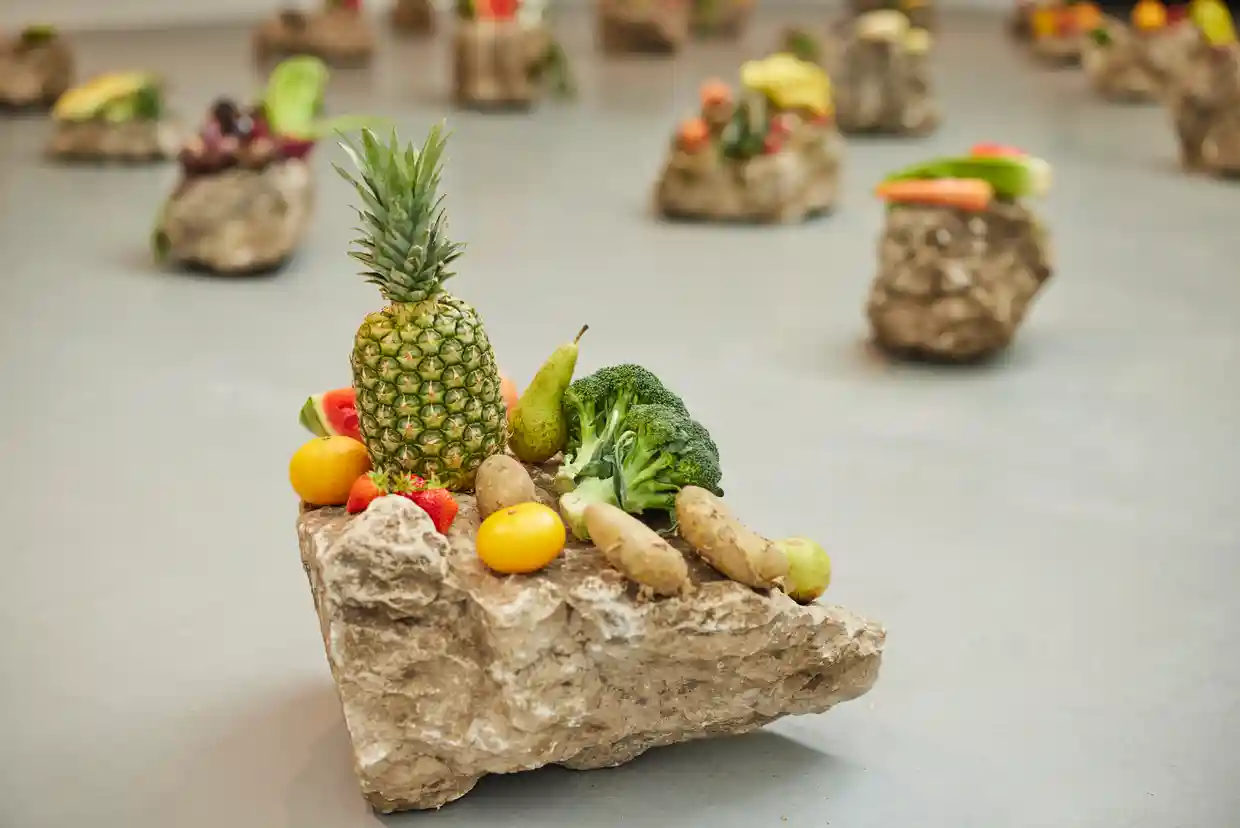The Observer
Liverpool Biennial 2023


The bloody legacy of the transatlantic slave trade looms large over Liverpool, which was the slave-trading capital of Britain by 1740. Many of the works featured in the 12th edition of the Liverpool Biennial, mostly by Black, Asian and Indigenous artists, appear to be haunted by the city’s dark past. Take Brazilian artist Isa do Rosário’s bright blue textile work Dance with Death on the Atlantic Sea. The long fabric, suspended from the ceiling, features patches of sketch-like paintings. The visceral brushstrokes evoke a sense of frenzy and close inspection reveals that the black dots and pieces of fabric represent Black people who lost their lives during the slave trade.
The title and theme of the 12th edition is uMoya: The Sacred Return of Lost Things. The word uMoya in the isiZulu language means spirit, breath, air, climate and wind. Independent Cape Town-based curator Khanyisile Mbongwa has set out to create “a call for ancestral and indigenous forms of knowledge, wisdom and healing”. She headed South Africa’s Stellenbosch Triennale in 2020 and previously worked as a curator for performative practices at the Norval Foundation. Liverpool Biennial director Sam Lackey said Mbongwa’s appointment was down to her “longstanding curatorial concerns around care and repair”.
The show features 35 artists from 25 countries exhibiting in eight galleries, museums and other indoor spaces and five outdoor sites. As well as the slave trade, the works grapple with the effects of colonialism on communities and the environment. They tell a horror story that does not seek to visually shock, but instead to spiritually awaken and stir.
The piece that is perhaps most overtly about the slave trade is Binta Diaw’s Chorus of Soil (2023), on display at the Tobacco Warehouse. The Senegalese-Italian visual artist uses soil to map an 18th-century plan of the Brooks slave ship, which, departing from Liverpool to the west coast of Africa, carried 5,000 enslaved people to the Caribbean between 1782 and 1804. It is almost 1:1 scale and a journey in itself to walk around, but once you consider that this vessel carried hundreds of people, for months on end, the work shrinks and feels minuscule. The ship was allowed to stow 454 African enslaved people, each man assigned a space of 6ft x 1ft 4in, with 5ft 10in x 1ft 4in for each woman. Being confronted with this configuration is a sobering reminder of the dehumanisation of enslaved people, treated like cargo.
At Tate Liverpool, American artist Torkwase Dyson, whose work often explores the intersection between Black liberation, ecology and architecture, presents three mammoth structures that demand silence. The curved constructions – Liquid a Place (2021) – are made from steel, brass, mirror and graphite and feel at home near Britain’s first commercial wet dock. There’s something ominous about their geometrical shape, which brings to mind a ship’s hull, or tombstones.
Scale seems to be a key component at the biennial, with many of the biennial works taking up large amounts of floor, wall or airspace. Even smell can occupy entire rooms. Inside the Cotton Exchange, an oil-like odour, evoking the petrol bombs used in civil protests in South Africa, emanates from Lungiswa Gqunta’s irregular-shaped and illuminated green floor sculptures. In contrast, the sweet scent of pineapple suffuses Tate Liverpool thanks to Guatemalan Edgar Calel’s Ru k’ox k’ob’el jun ojer etemab’el (The Echo of an Ancient Form of Knowledge) (2021), in which fruit and vegetables rest on stones in honour of his ancestral home and people.
Catastrophe is omnipresent throughout the biennial, but it is also a site of healing, as Mbongwa intended. Rudy Loewe’s bright and colourful installation is based upon his painting of Moko jumbie (a stilt walker) and carnival mas players, and is a scene of joy and emancipation. Several pieces are, like Calel’s work, built around the concept of “offering”, through the creation of sacred shrines dedicated to remembering ancestors. Charmaine Watkiss’s installation featuring mudlark finds is reminiscent of ancient burial sites in Africa and the Caribbean. Albert Ibokwe Khoza’s shrine featuring cow bones atop a pile of soil and surrounded by fruit, drinks and candles is in remembrance of Sarah Baartman, a Khoikhoi woman whose body was deemed as “grotesque” and exhibited around Europe in the 19th century.
The biennial’s strength – its connectivity and rapport – can sometimes be its weakness. Depending on your route around the city, you might encounter two or three works in a row that are very similar in materials or execution, which after a while can become redundant. Where the biennial does deviate, it veers too far off route. Such is the case with Melanie Manchot’s film project Stephen (2023), which uses a cast of professional actors and local people affected by gambling. It’s compelling, but feels out of place in a sea of work largely concerned with empire. Still, balancing dozens of global voices is a tough feat, and Mbongwa succeeds in giving each piece the breathing space it needs to feel both standalone and in conversation with others.
This edition of the Liverpool Biennial is a moving experience, but I strongly resist calling it timely. There are no new facts or information presented here; everything is old news. However, any time the gnarly shadows of the British empire are summoned to step into the light, as this biennial has done, it is a good thing.